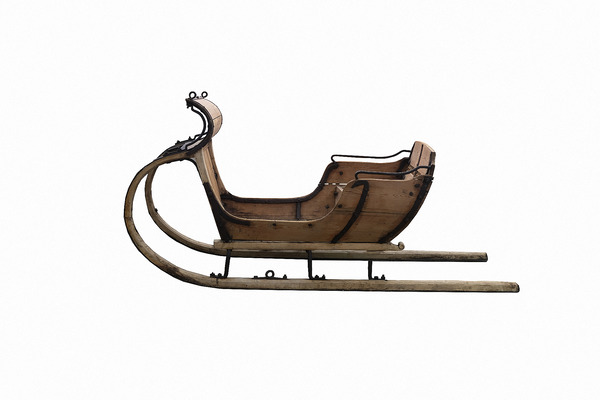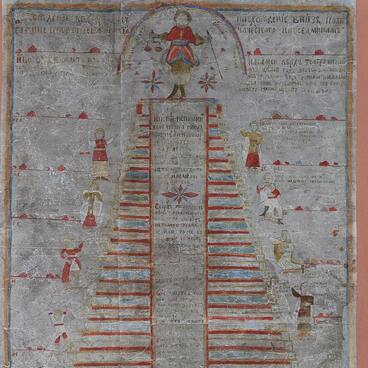Since ancient times, sleds have been an indispensable thing in everyday life in the snowy northern regions. According to purpose, they were divided into draft, household and passenger ones.
The museum houses a passenger sled. It is more nimble and faster than the other types. Passenger ones, as a rule, have an open body with relatively high sides; they also had a seat and a comfortable backrest with a headrest.
The body was mounted on two runners and attached to them using poppets — special short bars of wood or iron brackets. The sled from the museum collection has the runners bound with metal strips along the entire length for strength.
Ordinary sleds were made by residents themselves, but elegant festive ones were created by professional craftsmen. The Kargopol Uyezd was famous for this type of work. The Olonets statistical provincial committee even noted that the local masters created carriages of the best style and finishing.
The largest manufacturing center by the late 19th century was the Nifantovsky district, where there were 117 craftsmen. In the nearby Vytegorsky Uyezd, such a center was located in the Shildsky volost.
The carriagemakers received good additional income at that time — from 50 to 80 rubles a year (even though the main average salary of workers in Russia was 150–300 rubles a year). Unshod sleds could be bought for 4-5 rubles on the spot, custom-made or at the market — for 6–8 rubles, large twin sleds cost 8 rubles, and shod ones provided with tires cost about 12–17 rubles. Carefully crafted, elegantly and well-painted small sleighs for smooth riding were considered the most expensive ones — their price could go up to 18–25 rubles.
In sled making, runners are the most difficult element to craft. They were usually made of birch, which was first slightly abraded with an ax, then steamed in a bath or a black banya (where a stove was heated without smoke escaping through a chimney — it rose to the ceiling and went out through an open door or a special hole above it, and then escaped outside through a wooden pipe in the hallway). The steamed trunk was abraded thoroughly yet again with an ax and a scraper. The prepared birch was clamped between two logs and the end was slightly bent with a windlass — a rotating mechanism similar to a winch. After reaching the necessary bend, the wood was placed in a spacer or tied with a rope, and then left in a bent state until it was completely dry.
Depending on the size, sleds were either single, one-and-a-half or twin ones, depending on the team of horses that could consist of one, two or three animals. Noble and wealthy residents had a footman’s board in their carriages, where servants stood (there is no such board in the sled from the museum’s collection).
The museum houses a passenger sled. It is more nimble and faster than the other types. Passenger ones, as a rule, have an open body with relatively high sides; they also had a seat and a comfortable backrest with a headrest.
The body was mounted on two runners and attached to them using poppets — special short bars of wood or iron brackets. The sled from the museum collection has the runners bound with metal strips along the entire length for strength.
Ordinary sleds were made by residents themselves, but elegant festive ones were created by professional craftsmen. The Kargopol Uyezd was famous for this type of work. The Olonets statistical provincial committee even noted that the local masters created carriages of the best style and finishing.
The largest manufacturing center by the late 19th century was the Nifantovsky district, where there were 117 craftsmen. In the nearby Vytegorsky Uyezd, such a center was located in the Shildsky volost.
The carriagemakers received good additional income at that time — from 50 to 80 rubles a year (even though the main average salary of workers in Russia was 150–300 rubles a year). Unshod sleds could be bought for 4-5 rubles on the spot, custom-made or at the market — for 6–8 rubles, large twin sleds cost 8 rubles, and shod ones provided with tires cost about 12–17 rubles. Carefully crafted, elegantly and well-painted small sleighs for smooth riding were considered the most expensive ones — their price could go up to 18–25 rubles.
In sled making, runners are the most difficult element to craft. They were usually made of birch, which was first slightly abraded with an ax, then steamed in a bath or a black banya (where a stove was heated without smoke escaping through a chimney — it rose to the ceiling and went out through an open door or a special hole above it, and then escaped outside through a wooden pipe in the hallway). The steamed trunk was abraded thoroughly yet again with an ax and a scraper. The prepared birch was clamped between two logs and the end was slightly bent with a windlass — a rotating mechanism similar to a winch. After reaching the necessary bend, the wood was placed in a spacer or tied with a rope, and then left in a bent state until it was completely dry.
Depending on the size, sleds were either single, one-and-a-half or twin ones, depending on the team of horses that could consist of one, two or three animals. Noble and wealthy residents had a footman’s board in their carriages, where servants stood (there is no such board in the sled from the museum’s collection).



